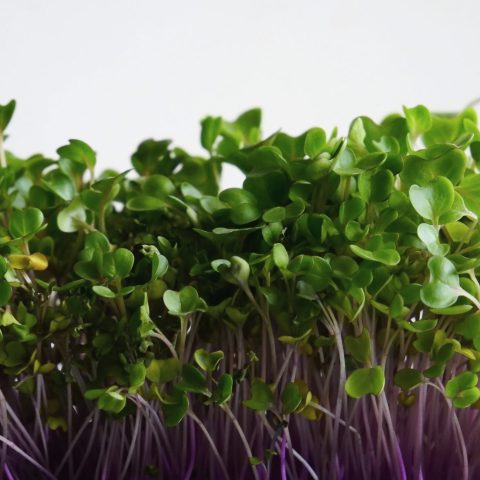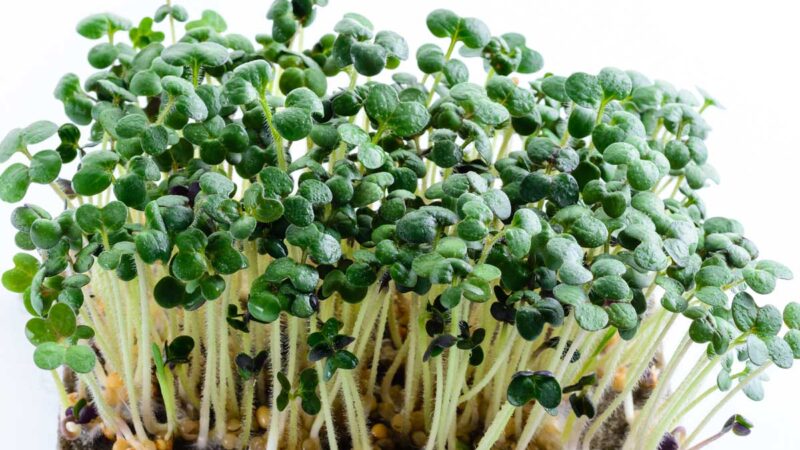Microgreens are more than just a culinary trend; it is a revolution in health and nutrition.
But what exactly is microgreens?
How to grow it and why is it so healthy?
Microgreen starter kit
In this article, we will delve into the fascinating world of microgreens and explore why these tiny plants have become so popular.
Table of contents
ToggleWhat are microgreens?
Microgreens are small plants grown from seeds of vegetables, herbs or flowers. They are harvested at a very young age, usually between 7-14 days after germination. By this time, the plants have developed their first set of true leaves, known as "cotyledons", and may begin to develop their second set of leaves, known as "true leaves".
Microgreens have become a fairly new term, but they cover many different kinds of young plants that can be grown all year round, both indoors and outdoors, giving many more opportunities to include them in your diet.

The difference between microgreens and sprouts
While microgreens and sprouts both represent early stages in a plant's life cycle, they contain significant differences. Sprouts are the first shoots to emerge from a seed and are typically harvested before they develop full leaves, as seen with bean sprouts. Microgreens are in an intermediate stage, making them easy to grow as sprouts, while still having the nutritional benefits of a more mature plant. They offer a unique opportunity to grow nutritious veg at an early stage of plant development.
| Micro greens | Spires | |
|---|---|---|
| Rich in essential nutrients and antioxidants | Rich in essential and valuable nutrients | |
| Varied flavour and texture | Mild flavour, crispy texture | |
| Versatile use in many dishes | Often used in sandwiches and salads | |
| Lower risk of bacterial contamination | Potential risk of contamination | |
| Requires more sunlight and growing space | Requires less sunlight and space |
Are microgreens healthy?
Yes, microgreens are incredibly healthy. They are full of vitamins, minerals, antioxidants and enzymes, which are essential for our health.
Research has shown that microgreens have a higher nutritional content than their full-grown counterparts. For example, a study published in the Journal of Agricultural and Food Chemistry found that microgreens contain up to 40 times more nutrients than full-grown plants.
This makes them an excellent source of nutrients and an easy way to increase your daily fruit and vegetable intake.
Health benefits of microgreens
Microgreens are known for their high concentration of nutrients, which exceed the levels in their full-grown counterparts. These tiny plants can contribute to improved digestion, stronger immune defences and may even have the potential to prevent certain chronic diseases. Including microgreens in your diet offers an easy and delicious way to boost your daily nutrient intake
| Health benefit | Description |
|---|---|
| High nutritional value | Contains higher concentrations of vitamins and minerals compared to fully grown plants. |
| Antioxidant Content | Rich in antioxidants, which can fight free radicals and reduce the risk of chronic diseases. |
| Promotes Good Digestion | High fibre content contributes to healthy digestion and prevents constipation. |
| Low Calorie | Low in calories, ideal for weight management or weight loss. |
| Improves Heart Health | Can help reduce blood pressure and improve cardiovascular health. |
| Supports the immune system | High levels of vitamins and minerals can strengthen the immune system. |
| Anti-inflammatory Effect | Some have been shown to have anti-inflammatory properties, beneficial in the treatment of inflammatory conditions. |
| Anti-Cancer Properties | Bioactive substances in some types are being studied for their potential to protect against cancer. |
How to grow your own organic microgreens all year round
Growing microgreens is relatively simple and does not require much space or equipment. Here's a step-by-step guide to growing microgreens:
- Choose your seeds: There are many different types of microgreens, so the first step is to choose which types you want to grow. Some popular choices include radishes, broccoli, clover, sunflower and peas, remember to choose organic seeds as they are tested for harmful bacteria and chemicals!
- Prepare your soil: Fill a flat tray or container with around 1-2 cm of coconut flour, Remember to choose a type that is leached of salts, otherwise the little plants can't grow! Or use a fibre mat or bamboo mat.
Order your coconut mulch here.
Sow your seeds: Sprinkle the seeds evenly over the soil surface. It is important not to sow the seeds too close, as this can lead to mold and fungal growth.
- Cover the seeds: Lightly cover the seeds with a thin layer of coconut mulch or put another tray on top with an extra weight/stone. This helps to retain the moisture and thus helps the seeds to germinate.
- Water your seeds: Use a fine mist spray bottle to gently water the soil. Make sure the soil is moist but not wet.
- Place the tray in a warm, bright area: Microgreens need plenty of light to grow, so place the tray in an area with plenty of natural light or under a groly's lamp.

- Keep the soil moist: It is important to keep the soil moist but not wet. Use a fine mist spray bottle to water the soil daily after you have removed the top tray. If you have chosen a microgreen tray with a lower tray, water in the lower tray.
- Harvest your microgreens: Once the plants have developed their first set of true leaves, they are ready to be harvested. This usually takes between 7-14 days, depending on the type of microgreens you are growing.
What seeds can you use to grow microgreens?
For microgreens, you must use organic seeds, most vegetable, herb and edible flower seeds can be used as long as they are certified organic. Here are some popular seeds that are often used to grow microgreens:
- Radish: Has a peppery flavour and a beautiful red colour. Perfect as a colourful addition to salads.
- Broccoli: Known for their high antioxidant content. Excellent in both raw and lightly steamed dishes.
- Clover: Has a mild, nutty flavour and is rich in protein, calcium and iron.
- Sunflower: Has a nutty flavour. Great in wraps or as a snack.
- Peas: Has a sweet and mild flavour. Delicious in fresh salads or as part of a healthy snack.
- Arugula:Has a peppery flavour. Perfect for adding a spicy note to salads.
- Beetroot:Has an earthy flavour and a deep red colour. Great for adding colour and flavour to salads.
- Cabbage: Known for their high nutrient content. Suitable for both raw and cooked dishes.
- Wheat grass: Known for their high chlorophyll content. Most commonly used in juices and smoothies.
- basil: Has a sweet and spicy flavour. A classic in Italian dishes.
- Cilantro: Has a fresh and citrusy flavour. Indispensable in many Asian dishes.
- Dill: Has a mild and aromatic flavour. Excellent in fish dishes and dressings.
- Spinach: Has a mild and earthy flavour. Versatile in both raw and cooked dishes.
- Mustard: Has a sharp and peppery flavour. Good as a spicy addition to salads.
- Buckwheat: Has a nutty flavour. Suitable as a gluten-free alternative in many recipes.
- Alfalfa: Has a mild and nutty flavour. Popular in sandwiches and salads.
- Fennel: Has a sweet and aniseed flavour. Delicious in salads and as a side dish.
- Parsley: Has a fresh and spicy flavour. A classic in many cuisines, from salads to sauces.
- Chia: Has a mild flavour. Excellent added to smoothies or as part of healthy desserts.
- Amaranth: Has a mild and nutty flavour. A great alternative to traditional grains in a variety of dishes.
- Quinoa: Has a mild and nutty flavour. Popular in salads and as a healthy addition to meals.
- Pumpkin: Has a sweet and nutty flavour. Suitable in both sweet and savoury dishes.
- Sesame: Has a mild and nutty flavour. Excellent addition to Asian dishes.
- Linseed: Has a mild and nutty flavour. Can be used in baked goods or as a topping on yoghurt.
- Onion: Has a sharp and spicy flavour. A staple ingredient in many cuisines.
- Garlic: Has a strong and spicy flavour. Indispensable in many dishes to add flavour.
- Rye: Has a mild and earthy flavour. Good in bread and other baked goods.
- Mizuna: Has a peppery and spicy flavour. Perfect for flavouring salads and soups.
- Pak Choi: Has a mild and earthy flavour. Great in stir-fry and steamed dishes.
See our diverse range of organic seeds.
It is important to remember that not all seeds are suitable for growing as microgreens. It is best to buy seeds specifically intended for microgreen growing as they are tested for pathogens and are safe to eat raw.
It is also important to follow the growing instructions carefully for each seed as they can vary in their light, water and temperature requirements.
Microgreen starter kit
Here you have the opportunity to buy our small starter packs or our micro garden. With a microgreen starter kit, you get an easy and fun way to grow your own superfood sprouts - fresh, crisp and packed with nutrition. It's a smart investment to boost your meals with an extra shot of vitamins and minerals.
- You can click here to move on to our starter packs.
FAQ - Frequently Asked Questions
Microgreens are young shoots of vegetables and herbs, harvested shortly after the first true leaves appear. Known for their high nutritional content, they add fresh flavour and colour to meals such as salads, sandwiches and smoothies. Microgreens are popular for their nutritional and aesthetic value.
The shelf life of microgreens varies depending on the type and storage conditions, but in general, you can expect microgreens to stay fresh for about 3-5 days after harvesting. To maximise shelf life, store them in the fridge in a container that allows some air circulation. It's also important to keep them dry, as too much moisture can accelerate spoilage. If you notice that microgreens start to wilt or develop a bad odour, it's a sign that they are no longer fresh and should be discarded.
Microgreens are high in vitamins, minerals and antioxidants, which can reduce the risk of diseases such as cardiovascular disease and cancer. They contain more nutrients per unit weight compared to full-grown vegetables. Their high fibre content promotes good digestion and can help with weight management. Microgreens also have potential anti-inflammatory properties that may be beneficial for those with inflammatory conditions.
As there are 2 different microgreen starter packs, their contents will vary, in the first microgreen starter pack (Microgarden) there are the following contents:
The Microgarden kit consists of
- LED grolys lamp with timer
- Under tray
- Spiral lid
- Top tray
- Power supply
- 2 x Bamboo germination mats (More can be purchased)
In the second of the sets, we have the microgreen starter kit where the contents are:
The Microgreen set consists of:
- LED grolys lamp with timer
- Kokus growth medium 9 Liter
- Medium sprout tray, blue
- 10 g. Broccoli Raab, Organic.
- 10 g. Beetroot, organic.
- 10 g. Radishes, Green, Organic.
- 10 g. Cress, organic.
- 50 g. Pea seeds, Eco.








